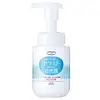What's inside
What's inside
 Key Ingredients
Key Ingredients

No key ingredients
 Benefits
Benefits

 Concerns
Concerns

 Ingredients Side-by-side
Ingredients Side-by-side

Water
Skin ConditioningDipropylene Glycol
HumectantGlycylglycine
Sorbitol
HumectantCoconut Acid
CleansingLauryl Betaine
CleansingCocamidopropyl Betaine
CleansingGlycerin
HumectantSerine
MaskingButylene Glycol
HumectantDisodium EDTA
EDTA
PEG-3 Cocamide
EmulsifyingGlycerylamidoethyl Methacrylate/Stearyl Methacrylate Copolymer
HumectantZinc Chloride
AntimicrobialZinc Carbonate Hydroxide
BufferingPhenoxyethanol
PreservativeWater
Skin ConditioningGlycerin
HumectantDipropylene Glycol
HumectantCoco-Betaine
CleansingTea-Cocoyl Glutamate
CleansingPotassium Lauroyl Glutamate
CleansingButylene Glycol
HumectantCitric Acid
BufferingSodium Citrate
BufferingNiacinamide
SmoothingHydrolyzed Silk
HumectantPhenoxyethanol
PreservativeLonicera Japonica Flower Extract
Skin ConditioningPerilla Ocymoides Leaf Extract
TonicCitrus Unshiu Peel Extract
MaskingAngelica Keiskei Leaf/Stem Extract
Skin ConditioningGlycyrrhiza Glabra Leaf Extract
Skin ConditioningPrunus Persica Kernel Extract
MoisturisingCoix Lacryma-Jobi Ma-Yuen Seed Extract
Skin ConditioningWater, Glycerin, Dipropylene Glycol, Coco-Betaine, Tea-Cocoyl Glutamate, Potassium Lauroyl Glutamate, Butylene Glycol, Citric Acid, Sodium Citrate, Niacinamide, Hydrolyzed Silk, Phenoxyethanol, Lonicera Japonica Flower Extract, Perilla Ocymoides Leaf Extract, Citrus Unshiu Peel Extract, Angelica Keiskei Leaf/Stem Extract, Glycyrrhiza Glabra Leaf Extract, Prunus Persica Kernel Extract, Coix Lacryma-Jobi Ma-Yuen Seed Extract
Ingredients Explained
These ingredients are found in both products.
Ingredients higher up in an ingredient list are typically present in a larger amount.
Butylene Glycol (or BG) is used within cosmetic products for a few different reasons:
Overall, Butylene Glycol is a safe and well-rounded ingredient that works well with other ingredients.
Though this ingredient works well with most skin types, some people with sensitive skin may experience a reaction such as allergic rashes, closed comedones, or itchiness.
Learn more about Butylene GlycolDipropylene Glycol is a synthetically created humectant, stabilizer, and solvent.
This ingredient helps:
Dipropylene glycol is technically an alcohol, but it belongs to the glycol family (often considered part of the ‘good’ alcohols). This means it is hydrating and gentle on skin unlike drying solvent alcohols like denatured alcohol.
As a masking agent, Dipropylene Glycol can be used to cover the smell of other ingredients. However, it does not have a scent.
Studies show Dipropylene Glycol is considered safe to use in skincare.
Learn more about Dipropylene GlycolGlycerin is already naturally found in your skin. It helps moisturize and protect your skin.
A study from 2016 found glycerin to be more effective as a humectant than AHAs and hyaluronic acid.
As a humectant, it helps the skin stay hydrated by pulling moisture to your skin. The low molecular weight of glycerin allows it to pull moisture into the deeper layers of your skin.
Hydrated skin improves your skin barrier; Your skin barrier helps protect against irritants and bacteria.
Glycerin has also been found to have antimicrobial and antiviral properties. Due to these properties, glycerin is often used in wound and burn treatments.
In cosmetics, glycerin is usually derived from plants such as soybean or palm. However, it can also be sourced from animals, such as tallow or animal fat.
This ingredient is organic, colorless, odorless, and non-toxic.
Glycerin is the name for this ingredient in American English. British English uses Glycerol/Glycerine.
Learn more about GlycerinPhenoxyethanol is a preservative that has germicide, antimicrobial, and aromatic properties. Studies show that phenoxyethanol can prevent microbial growth. By itself, it has a scent that is similar to that of a rose.
It's often used in formulations along with Caprylyl Glycol to preserve the shelf life of products.
Water. It's the most common cosmetic ingredient of all. You'll usually see it at the top of ingredient lists, meaning that it makes up the largest part of the product.
So why is it so popular? Water most often acts as a solvent - this means that it helps dissolve other ingredients into the formulation.
You'll also recognize water as that liquid we all need to stay alive. If you see this, drink a glass of water. Stay hydrated!
Learn more about Water